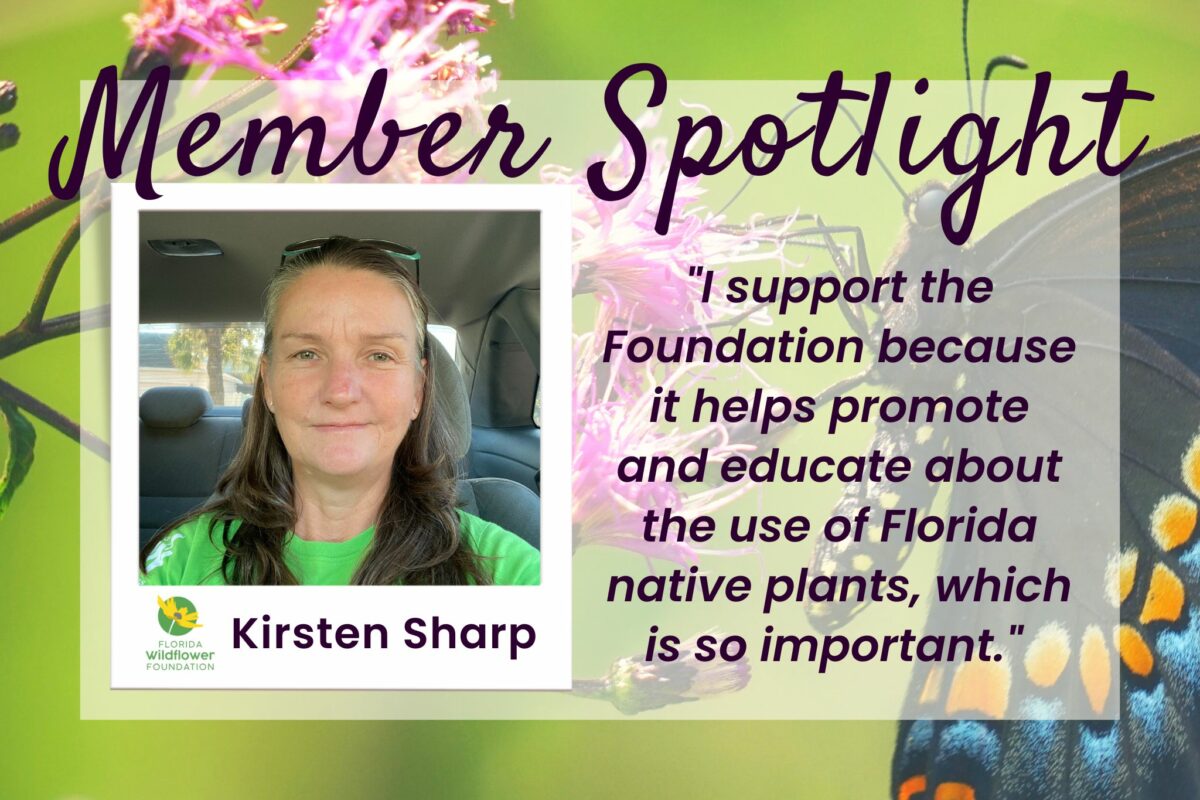Member Spotlight: Kirsten Sharp

Kirsten is a habitat designer and horticulturalist.
Q&A with Kirsten
Why do you support the Florida Wildflower Foundation?
I support the Foundation because I know how important it is to support the use of native plants in Florida. There is so much development going on here that it would be good to get more and more people to plant native plants, and the Foundation helps promote and educate about this. The Foundation also does important outreach and has some fantastic publications that give you a lot of information about our native plants. So please support the Florida Wildflower Foundation!
Why should others care about Florida’s native wildflowers?
Native flowers grew here naturally; they do not need soil amendments and extra water once established. They can handle our summer heat and rains and our dry periods. When planted in the right location they will drop their seeds, thrive and give you years of pleasure and enjoyment. Not only does planting native species save you money by reducing water, herbicide and pesticide use, but it also helps create habitat for our wildlife that make Florida their home. Native plants provide food in the form of nectar and pollen for our pollinators and some produce berries for our small mammals and birds.
What is your favorite Florida native wildflower and why?
You ask me to only pick one and that is really hard because I love so many of them! Over the years, I have seen how many pollinators use native plants; in fact, I live in a guest house in a garden that I designed about five years ago and it is so full of butterflies, bees and other insects and wildlife that is it heaven. I see living proof every day of the reason why it is important to use native plants in any garden design no matter how big or small.
Some of my favorites are, in no particular order of preference (and because I can’t pick only one!): Rosinflower (Silphium asteriscus) — a sunny perennial that just keeps on giving with flower spikes that have multiple flowers that can get up to 4 feet and sometimes higher! Giant ironweed (Vernonia gigantea) — beloved by hummingbirds, butterflies and bees alike, and this year mine flowered twice! Stokes Aster (Stokesia laevis) — offers a nice big landing pad for the butterflies that frequent it and such a pretty shade of blue and white. Purple coneflower (Echinacea purpurea) — Who does not love these flowers! Pollinators just love them, from the smallest iridescent bees to the largest butterflies! Tropical sage (Salvia coccinea) — flowers in sun or shade and keeps on giving. Another hummingbird magnet and important for larger butterflies like the Monarchs and Swallowtails. Blue porterweed (Stachytarpheta jamaicensis) — the tiniest of true-blue flowers and they taste like mushrooms, too! A great plant for the smaller butterflies like the Skipper and Sulphur. Button sage or Wild sage (Lantana involucrata) — This perennial just keeps on giving flowers for the pollinators and berries for the birds. I have counted approximately 12 different species of insects using this plant in one go! And I watched mockingbirds do acrobatics to get to the berries! And of course, Firebush (Hamelia patens) — No native garden is complete without one! This shrub or small tree is the go-to for so much wildlife that it literally hums from all the bees, the birds love the berries that start forming from mid-summer on, and to top it all off, it can have some spectacular autumn and winter coloring if we do not have any freezes. (If we do, it usually comes back from the ground!).
Hopefully, this gives people pause to think of native wildflowers and to use them in their garden. They will not regret it for one minute because “If you plant them, they will come!”
Join Kirsten in supporting the Foundation by becoming a member or making a donation to support our work.
